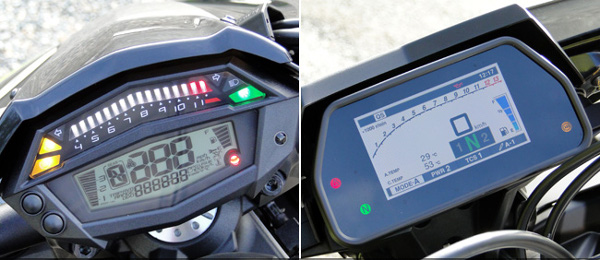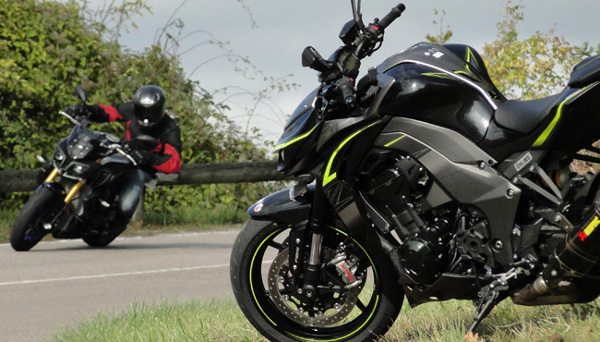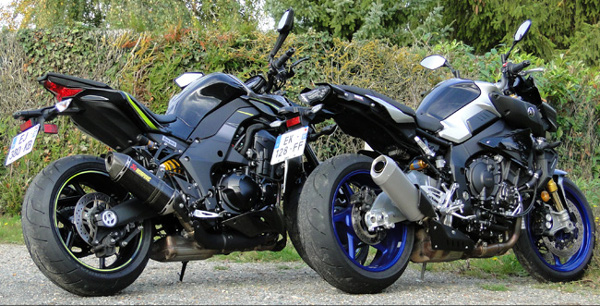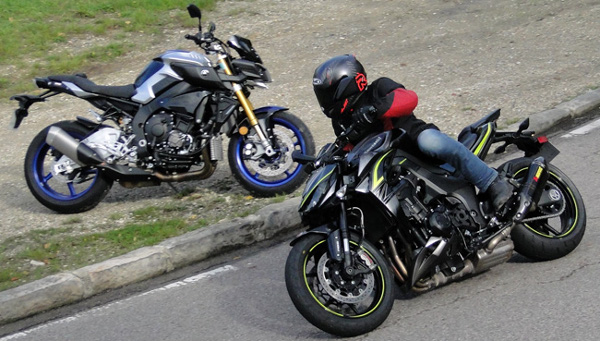Sharpened by high-end peripherals, the Kawasaki Z1000R and Yamaha MT-10 SP embody the quintessence of high-performance Japanese high-performance roadsters. Their 4-cylinder survitaminés and their facies tortured confirm it: this new duel enginewar.com will be explosive! "What happened with your bike, you've fallen, the front is damaged?!" The joke falls flat, but the spike is fly: this MT-10 SP is the perfect antithesis of a fluid and elegant design. What a face! The Yamaha roadster pours in an aggressive register, Transformers way raised in the manga sauce. Let's recognize its designers an overflowing imagination! That said, the Z1000R in front of her has nothing to envy: since its redesign in 2014, the Kawasaki and its reptilian style "Sugomi" is not exactly exquisite beauty. Bestiale? Yes. Graceful? No ! Its squat front end challenges as much as its optics flattened, oddly low, intimidated. These two hyper sports roadsters frighten children, even during Halloween!
READ MORE :Duel Aprilia 125 rs4 vs Yamaha YZF R125
Kawasaki Z1000R VS Yamaha MT-10 SP
No other motorcycle of Japanese production pushes the aesthetic bias so far. Who said "fortunately"?! But their similarities do not stop at these stylistic considerations: their 4-cylinder of 1043 cc (Z1000) and 998 cc (MT-10) also have in common a solid temperament. The visual slap is nothing compared to the huge slap administered by these fire pumps! On this point again, they have no rival in the land of the rising sun.
This nervousness is particularly palpable on the 4-legged asynchronous setting of the MT-10 SP, which eclipses the Z1000R when it starts with its rocky melody with V4 accents. Small disappointment for the Kawasaki, whose sweet and metallic song is not especially valued by its optional Akrapovic. Its double original pots, at least as sonorous - even more? - fit better in the overall silhouette. The technical spec may help you decide!
Last similarity between the two: like some European motorcycles, the Z1000 and the MT-10 are available in sportier version - designated by the suffix "R" and "SP" - strong of attractive devices charged with sublimating their dynamic qualities. Must say that their original bike part is put to the test with the 142 hp viral spewed by the Kawasaki and the 160,4 naggers (qualifier particularly appropriate!) Of the Yamaha.
If their engine and their perimeter frame are "stock", their suspensions rise seriously in rank, especially on the MT-10 SP: the Yam 'receives nothing less than the Öhlins forks and damper with electronic calibration of the Superbike R1M. It also boasts the standard R1 single-effect shifter (mounted reports only) and its complete TFT matrix color instrumentation well arranged, in addition to being controlled from the handlebars.
In comparison, the monochrome dashboard of the Z1000R and its multicolor tally Christmas wreath take a serious shot of old. The comparison is all the more disadvantageous because its information is quite small and scrolling requires a button on the dashboard. In this declination "R", the Kawasaki on the other hand exposes brembo monobloc calipers radial fixation more rewarding than the radial 4-pistons - yet not disgusting - the Yamaha. The same goes for its "aviation" metal hoses (rubber on MT-10, as on standard Z1000). Its sporty fiber is further enhanced by the grafting of a fully adjustable rear shock Öhlins, which we appreciate the remote wheel to adjust the preload.
Its inverted fork comes from the basic "Zed", as well as its very limited electronic assistance. It's simple: except ABS, it does not carry any "chip"! Fun in some cases, questionable in others: despite its very good traction, a traction control would not be too much to ride serenely all year. A "comma" involuntarily left by enginewar.com early in a curve still wet is there to testify.
All the opposite of the MT-10 SP, on which electronics reign supreme! Traction control adjustable on three levels and disconnectable (TCS), parameterization of the reactivity engine (Power), automatic or manual adjustment of its luxurious Swedish suspensions (NIX30 in the front and TTX36 in the back): the MT-10 SP is a real "flea bag"!
In this, it is positioned as a R1 in little outfit and its price is felt: € 15,999 (the price of a R1 in 2012 !) Against € 14 199 for the Z1000R. Not given, the "monsters"! To simplify its use, driving modes (A, B, C, D) offer pre-programmed values for each function. Then everyone can adjust them manually to shape modes to his hand: more responsiveness engine (not too much, because its ride-by-wire is ticklish!), No traction control and a firm damping to keep it off, the opposite for everyday life. And why not also a mode "all soft" at the engine level and suspensions for the duo trips? Several motorcycles in one, in short!
The only problem: switching from one mode to another requires being stopped, while the logic would be that we can change the configuration according to the state of the road. The traction control that reactivates automatically after each stop of the engine will also frustrate wheeling fans, natural figure for the MT-10 thanks to its extreme geometry (1400 mm wheelbase against 1435 mm for the Z1000), its light weight (210 kg against 221) and its mechanical strength!
Duel Yamaha MT-10 SP Vs Kawasaki Z1000R
Sharpened by high-end peripherals, the Kawasaki Z1000R and Yamaha MT-10 SP embody the quintessence of high-performance Japanese high-performance roadsters. Their 4-cylinder survitaminés and their facies tortured confirm it.
The Hulk against Goliath, Hercules vs. Musclor: this is the kind of game of colossal proportions inspired by our repeat tests between the MT-10 SP and the Z1000R! This surge of power is perpetual: no matter the relationship engaged, one like the other pushes hell. And that's good, because their selection is rather rough: long live the shifter on the Yamaha! Especially sensational, the MT-10 SP gives the impression of having an account to adjust with the bitumen with each acceleration: its rear tire in 190 mm (idem for the Z) bites the road with such ferocity that one fears almost to see the tar fripper! This "CP4" takes its turns with incredible promptness and enjoyable savagery: of all Japanese motorcycles, the MT-10 is undoubtedly the most character.
Uncomfortable at very low speeds (when the Z1000 purrs like a cat), the Yamaha rushes correctly from 2000 rpm, then shoots its first club blows at 4000 rpm. His insane respondent - divinely amplified by his MotoGP soundtrack - is fearing the worst for the Z1000. Serious mistake: the Kawasaki, less sensational but certainly no less effective, is better than defending itself!
Pushing all our predictions, the Green Akashi stands up to his rival Iwata: better, it dominates in the first third of the tachometer! And this resistance does not come from any difference in gear ratio: the speeds are almost identical on all the ratios, with at best 250 rev / min more for the Kawasaki (5500 rpm to 130 km / h in 6th for the Yam 'against 5750 for the Kawasaki). In short: the Zed does not shoot especially shorter than the MT.
Its 4-cylinder is like a steamroller: its hardened steel muscles develop phenomenal strength. And this hell fishing extends to all diets, without any downsizing. Implacable! The rough thrusts sent by his rival are certainly more exciting, but they come up against the bewildering consistency of the Z1000R. Once again, enginewar.com congratulates the Kawasaki engine manufacturers!
Those who hold the 4-cylinder in line for architecture "devoid of character" are invited to try one of these two bikes: your benchmarks will be permanently shaken! And if the Yamaha ends up imposing its additional 20 hp and its extension (12 000 r / min at the breaker against 11 000), it needs enough space and a license to 10,000 points!
Both, however, have some small flaws: the Z1000 still vibrates as much - sensitive from 4000 rpm and painful from 7000 rpm - when the M-10 suffers only slight quivering but heats up enormously in the city. Their gas grips also offer a precise and proportional response, but tainted by jerks on the go-around.
The Yamaha is particularly greedy: from 6.48 to 8.2 l / 100 km on average during this test, against 5.38 to 6.71 l / 100 km for the Z1000. In "sporty" driving, its volcanic temperament can even cause it to exceed 9 l / 100 km! Suffice to say that the local pump attendant will quickly tuture you by filling his tank of 17 liters (like the Z1000)!
Comfort side, no jealous: both have a solid oak saddle - 10 mm higher on the Yamaha: 825 mm - under which no storage space is provided. The Yamaha scores points every day thanks to its 12V socket near the dashboard, its unexpected cruise control and slightly better turning radius than the Z1000R.
Hang on the branches!
In the winding, the MT-10 SP retains the slight advantage of its engine - with a lot of effort! - thanks to its recent design and 11 kg less. The bets on the corner are of a disconcerting ease, for the benefit of a dynamic driving. She enjoys the entrances in curves bleeding, helped by a very communicative front train: the connection "tire-front-handlebar" is crystal clear. In this, the Yamaha is on par with the best European bikes.
However, to lead the whip requires more physical involvement than the Z1000R and especially a lot of coolness! The reason ? The fickle temper of his front wheel, which points straight to the sky if the gases are open wide on the first three reports. Fun and exhilarating on a bitumen smooth, but weary - even scary - on the bumpy portions.
Green is not as sharp when triggered and tends to widen out due to inertia, but in return it veers as laid on a rail. The Z1000R benefits from a less explosive power output, so easier to handle, but also from a position better suited to sporty driving. To begin with its tank very indented, in which literally fit the thighs instead of dismissing them as does the Yamaha. In addition, the Kawasaki has a lower fixed handlebar that gently tilts the bust forward, in favor of better control. Conversely, like the entire "MT" series, the Yamaha cultivates the ergonomic paradoxes: its footrests are more remote - sporty - but its handlebar is extremely wide and raised a bit like on a trail.
This "hybrid" position - which one has to get used to - certainly plays a role in its propensity to go away frequently in wheeling: the pilot is more straightened and especially more backward than on the Z1000R, whose front gear is consequently more plated. on the ground by the support of the body. While when the pace accelerates, leaning the bust towards the driving position becomes an obligation on the MT-10 SP!
The best is not always the friend of good
In this frame "arsouillesque", enginewar.com thought that the sophisticated equipment Yamaha Öhlins would make the difference: again, error! Far too firm in automatic modes, its electronic damping requires bitumen virgin of any irregularity. A circuit, in biker jargon! Or the perfectly maintained roads of South Africa on which Yamaha has - voluntarily? - introduced this version last year.
In "real" life, on the small roads of the French secondary network, the Kawasaki pulls out of the game: thanks to its Öhlins shock absorber, the Z1000R offers the progressiveness and responsiveness that painfully faults the "Zed" standard. A treat in every way! Efficiency, comfort, stability: Green is solid. Same satisfaction as its exceptional braking, more powerful and yet easier to dose than that of the MT-10. Too restless in the bumpy portions, the MT-10 SP is penalized by the dryness of its damping, which is as detrimental to the directional precision as to its traction. Automatic mode "A1" (the sportiest) or "A2" (less firm), nothing works: the Yamaha tends to bounce on shocks instead of absorbing them. Beside, the Zed passes for a flying carpet!
A little frustrated, enginewar.com has studied the innumerable adjustments proposed by the manual modes (M1, M2 and M3): the hydraulics is not managed any more in real time by the electronics, but works in a range defined by the user. The Journal moto du Net has programmed three configurations: one with a very firm calibration, the second with intermediate settings and the last frankly flexible. And it's a revelation: the time is not lost, believe us!
The differences are striking and the behavior with the intermediate option allows to have an efficient and comfortable motorbike, far from the end of wood bouncing on the bumps induced by the automatic modes A1 and A2. In addition, the operation of the suspensions is more predictable and constant, in short more natural than in "Full Auto" management. Tested and approved !
Verdict: the MT-10 SP is the strongest head!
Transcendée by its necessary adjustments of amortization, the MT-10 SP fixes easily to the basques of the Z1000R for which the part is complicated suddenly! Well tuned, Yamaha can finally spread its star arguments: a hyper-lively engine, a superior dynamism and a significant help from electronics. Green is starting to blush.
Faced with this "R1 string", the Z1000R is jostled and finally dominated: the MT-10 SP is both more sensational and more effective provided however to refine its "suspensions fleas". Like what, a "good old" well tuned mechanical damper is preferable to a display of sophistication to perfectible calibration. A word to you!
In the end, it is a generational conflict between these two motorcycles: despite very, very, beautiful remains, the "Zak" begins to show the weight of a slightly older design. A small diet and some electronic safety nets would easily put it back on top. As for its engine, it's simple: with the exception of its vibrations to eradicate, do not touch anything, Mr. Kawasaki!
The next vintage of the Z1000 should meet these expectations in the near future: given the pace of renewal at Kawasaki, the roadster is expected to evolve by 2019. Unless the Greens decide to leave free the recent Z900 by removing the Z1000? Possible!
Nevertheless, keeping a double offer is interesting with one side of the Z900 more accessible and the other Z1000R with increased potential. The assurance that all bikers will find their account! The Z1000R is also renewed as is this year, with a few cosmetic exceptions: compared to the 2017 model tested here, the Z1000R 2018 adopts particularly refined indicators. The battle is not over between the most "monstrous" Japanese roadsters and stay connected! By Alexandre BARDIN to moto-net.com.
MT-10 SP Vs Z1000R: Equipment and Practical Aspects
| Kawasaki Z1000R | Yamaha MT-10 SP | |
Instrumentation
| ||
| Daily trip | 2 | 2 |
| Gas gauge | Yes | Yes |
| Engine temperature | Yes | Yes |
| Outside temperature | no | Yes |
| Clock | Yes | Yes |
| Engaged report indicator | Yes | Yes |
| Consumption indicator | Yes | Yes |
| Handlebar Controls | no | Yes |
Convenient
| ||
| Coded key | Yes | Yes |
| Warning | Yes | Yes |
| Adjustable brake lever | yes (6 pos) | yes (5 pos) |
| Adjustable clutch lever | yes (5 pos) | no |
| Passenger handles | no |
no
|
| Lashing hooks | 2 | 2 |
| Central stand | no | no |
| Av adjustable suspension | yes (pre, comp and det) | yes (via email) |
| Ar adjustable suspension | yes (pre, comp and det) |
yes (via email)
|
| Steering damper | no |
Yes
|
| Valves bent | no | no |
| Hoses "avia" | Yes | no |
| Container capacity | any | any |
| Electrical outlet | no | 12V (near instrumentation) |
Electronics - flight aids
| ||
| ABS | Yes | Yes |
| Shifter | no | yes (climb only) |
| Traction | no | yes (adjustable and deactivatable) |
| Adjustable mapping | no | yes (Power 1, 2 and 3) |
| Modes of driving | no | yes (A, B, C, D) |
| Speed regulator | no | Yes |
| Kawasaki Z1000R | Yamaha MT-10 SP | |
Duel MT-10 SP Vs Z1000R: Technical Specifications
| Kawasaki Z1000R |
Yamaha MT-10 SP
| ||
Engine
| |||
| Type | 4-cylinder in line, 4 stroke | 4-cylinder in line, 4 stroke | |
| Displacement | 1043 cc | 998 cc | |
| Bore x stroke | 77 x 56 mm | 79 x 50.9 mm | |
| Cooling | Liquid | Liquid | |
| Distribution | Double ACT, 4 valves / cyl | Double ACT, 4 valves / cyl | |
| Tx compression | 11.8: 1 | 12: 1 | |
| Power | 142 hp at 10,000 rpm | 160.4 hp at 11,500 rpm | |
| Couple | 111 Nm at 7300 rpm | 111 Nm at 9000 rpm | |
| Food | Electronic injection | Electronic injection | |
| Ignition | Electronic | TCI electronics | |
| Start-up | Electric | Electric | |
Transmission
| |||
| Clutch | Multidisc in oil bath, anti-roll | Multidisk in oil bath, with anti-roll | |
| Gearbox | 6 reports | 6 reports | |
| Final transmission | By chain | By chain | |
Cycle part
| |||
| Frame | Perimeter aluminum | Perimetric aluminum (Deltabox) | |
| Av Suspension | Inverted fork 41 mm Showa. Adjustable in compression, preload and relaxation | Inverted fork 43 mm Öhins.Electronic adjustable | |
| Av Travel | 120 mm | 120 mm | |
| Suspension Ar | Öhlins single shock. Adjustable in preload (remote wheel), relaxation and compression | Öhlins single shock. Electronic settings. | |
| Deflection Ar | 131 mm | 120 mm | |
| Av Brake | 300 mm double disc, Brembo radial monoblock 4-piston calipers | Double 320 mm disc, 4-piston radial callipers | |
| Ar Brake | 1 disc of 250 mm, 1-piston caliper | 1 disc of 220 mm, single piston caliper | |
| Av Rim | A sticks, molded aluminum | A batons, molded aluminum | |
| Rim Ar | A sticks, molded aluminum | A sticks, molded aluminum | |
Dimensions, weight, capacities
| |||
| Length | NC | 2 095mm | |
| Width | NC | 800 mm | |
| Saddle height | 815 mm (not adjustable) | 825 mm (not adjustable) | |
| Hunting angle | 24 5 | 24 ° | |
| Hunt | 101 mm | 102 mm | |
| wheelbase | 1435 mm | 1400 mm | |
| Ground clearance | 125 mm | 130 mm | |
| Av tire | 120/70/17 | 120/70/17 | |
| Ar tire | 190/50/17 | 190/55/17 | |
| Weight all full facts (announced) | 221 kg | 210 kg | |
| Fuel tank | 17 liters | 17 liters | |
| Oil capacity | NC | 3.9 liters | |
| Commercial information | |||
| Availability | Immediate in the Kawasaki France network | Immediate in the network Yamaha France | |
| color | Black and gray only | Blue and silver only | |
| Guarantee | 2 years pieces and MO | 2 years pieces and MO | |
| Price | $ 14,199 | $ 15,999 | |
| Kawasaki Z1000R | Yamaha MT-10 SP | ||

















1 komentar:
Write komentarNice review..
ReplyEmoticonEmoticon